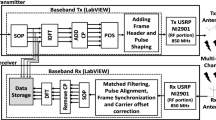Abstract
A study on the joint channel and symbol estimation issue is provided for two hop relay networks which employ the amplify-and-forward (AF) relaying approach. The encoding scheme at the source node introduces the time-domain spreading with a time-varying linear constellation precoding. Then, a set of amplifying factors matrices is utilized by the relays to amplify and forward the received data to the destination. The received signal at the destination can be constructed as a fourth-order tensor model, which is referred to as the nested parallel factor (PARAFAC) model. And then, we present a novel Levenberg-Marquardt (LM) algorithm based on this tensor model. The proposed method does not require complex signal processing at the relay, which effectively reduces the burden of relay. As a semi-blind method, which does not require the pilot signal, the proposed receiver can jointly recover the channels and information symbols. Moreover, the proposed semi-blind receiver is robust as it can work in different wireless channel scenarios. Simulations are conducted to demonstrate the efficiency of the proposed semi-blind approach.
Similar content being viewed by others
References
LANEMAN J N, TSE D N C, WORNELL G W. Cooperative diversity in wireless networks: Efficient protocols and outage behavior [J]. IEEE Transactions on Information Theory, 2004, 50(12): 3062–3080.
SANGUINETTI L, D’AMICO A A, RONG Y. A tutorial on the optimization of amplify-and-forward MIMO relay systems [J]. IEEE Journal on Selected Areas in Communications, 2012, 30(8): 1331–1346.
RONG Y. Joint source and relay optimization for two-way linear non-regenerative MIMO relay communications [J]. IEEE Transactions on Signal Processing, 2012, 60(12): 6533–6546.
HAMMERSTROM I, WITTNEBEN A. Power allocation schemes for amplify-and-forward MIMO-OFDM relay links [J]. IEEE Transactions on Wireless Communications, 2007, 6(8): 2798–2802.
LI M, LIN M, YU Q, et al. Optimal beamformer design for dual-hop MIMO AF relay networks over rayleigh fading channels [J]. IEEE Journal on Selected Areas in Communications, 2012, 30(8): 1402–1414.
RONG Y. Optimal joint source and relay beamforming for MIMO relays with direct link [J]. IEEE Communications Letters, 2010, 14(5): 390–392.
KONG T, HUA Y B. Optimal design of source and relay pilots for MIMO relay channel estimation [J]. IEEE Transactions on Signal Processing, 2011, 59(9): 4438–4446.
SIDIROPOULOS N D, GIANNAKIS G B, BRO R. Blind PARAFAC receivers for DS-CDMA systems [J]. IEEE Transactions on Signal Processing, 2000, 48(3): 810–823.
SIDIROPOULOS N D, BUDAMPATI R S. Khatri-Rao space-time codes [J]. IEEE Transactions on Signal Processing, 2002, 50(10): 2396–2407.
DE ALMEID A L F. Blind joint detection and channel estimation in space-frequency diversity systems using time-varying linear constellation precoding [EB/OL]. [2018-05-14]. https://www.researchgate.net.
DE ALMEID A L F, FAVIER G. Double Khatri-Rao space-time-frequency coding using semi-blind PARAFAC based receiver [J]. IEEE Signal Processing Letters, 2013, 20(5): 471–474.
RONG Y, KHANDAKER M R A, XIANG Y. Channel estimation of dual-hop MIMO relay system via parallel factor analysis [J]. IEEE Transactions on Wireless Communications, 2012, 11(6): 2224–2233.
DU J H, YUAN C W, ZHANG J B. Low complexity PARAFAC-based channel estimation for non-regenerative MIMO relay systems [J]. IET Communications, 2014, 8(12): 2193–2199.
XI H, DE ALMEID A L F. Multiuser receiver for joint symbol/channel estimation in dual-hop relaying systems [J]. Wireless Personal Communications, 2015, 83(1): 17–33.
DU J H, YUAN C W, HU Z W, et al. A novel tensor-based receiver for joint symbol and channel estimation in two-hop cooperative MIMO relay systems [J]. IEEE Communications Letters, 2015, 19(11): 1961–1964.
XIMENES L R, FAVIER G, DE ALMEID A L F. Semi-blind receivers for non-regenerative cooperative MIMO communications based on nested PARAFAC modeling [J]. IEEE Transactions on Signal Processing, 2015, 63(18): 4985–4998.
BRO R. Multi-way analysis in the food industry: Models, algorithms, and applications [D]. Amsterdam, Netherlands: University of Amsterdam, 1998.
KRUSKAL J B. Three-way arrays: Rank and uniqueness of trilinear decompositions, with application to arithmetic complexity and statistics [J]. Linear Algebra and Its Applications, 1977, 18(2): 95–138.
NION D, DE LATHAUWER L. A block component model-based blind DS-CDMA receiver [J]. IEEE Transactions on Signal Processing, 2008, 56(11): 5567–5579.
DE ALMEID A L F, FAVIER G, XIMENES L R. Space-time-frequency (STF) MIMO communication systems with blind receiver based on a generalized PARATUCK2 model [J]. IEEE Transactions on Signal Processing, 2013, 61(8): 1895–1909.
MARQUARDT D W. An algorithm for least-squares estimation of nonlinear parameters [J]. Journal of the Society for Industrial and Applied Mathematics, 1963, 11(2): 431–441.
DA COSTA M N. Tensor space-time coding for MIMO wireless communication systems [D]. Campinas, Brazil: University of Campinas, 2014.
MADSEN K, NIELSEN H B, TINGLEFF O. Methods for non-linear least squares problems [M]. Copenhagen, Denmark: Technical University of Denmark, 2004.
SHIU D S, FOSCHINI G J, CANS M J, et al. Fading correlation and its effect on the capacity of multielement antenna systems [J]. IEEE Transactions on Communications, 2000, 48(3): 502–513.
ZHOU L, WU D, DONG Z J, et al. When collaboration hugs intelligence: Content delivery over ultra-dense networks [J]. IEEE Communications Magazine, 2017, 55(12): 91–95.
ZHOU L, WU D, CHEN J X, et al. When computation hugs intelligence: Content-aware data processing for industrial IoT [J]. IEEE Internet of Things Journal, 2018, 5(3): 1657–1666.
TSAKNAKIS I C, GIAMPOURAS P V, RONTO-GIANNIS A A, et al. A computationally efficient tensor completion algorithm [J]. IEEE Signal Processing Letters, 2018, 25(8): 1266–1270.
Author information
Authors and Affiliations
Corresponding author
Additional information
Foundation item: the National Natural Science Foundation of China (Nos. 61601414 and 61701448), the National Key Research and Development Program of China (No. 2016YFB0502001), and the Fundamental Research Fund for the Central Universities (Nos. 2018CUCTJ082 and CUC18A007)
Rights and permissions
About this article
Cite this article
Lin, H., Yuan, C., Du, J. et al. Tensor-Based Joint Channel Estimation and Symbol Detection for AF MIMO Relay Networks. J. Shanghai Jiaotong Univ. (Sci.) 25, 88–96 (2020). https://doi.org/10.1007/s12204-019-2077-3
Received:
Published:
Issue Date:
DOI: https://doi.org/10.1007/s12204-019-2077-3
Key words
- fourth-order tensor
- semi-blind receiver
- Levenberg-Marquardt algorithm
- nested parallel factor model
- amplify-and-forward




